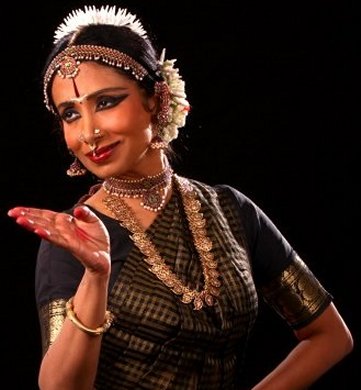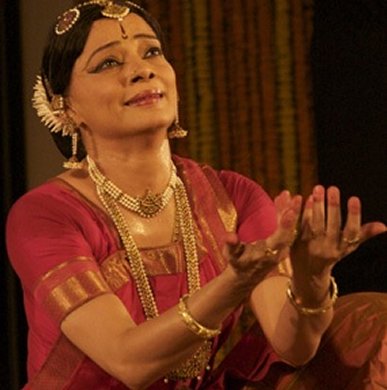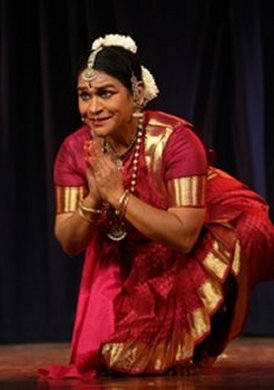
|
 |

|
 |
Abhinaya - The most relevant and contemporary of our repertoire - Amrita Lahiri e-mail: amrita.lahiri@gmail.com May 14, 2019 As a teenager, I watched Priyadarsini Govind dance for the first time, at the Smithsonian in Washington D.C. in the 90's. I thought a sculpture had truly come to life! I tried to find some flaw, but she was simply perfect from every angle. Back then, it was her pure dance movements that impressed me the most- the stretch of those long arms, the aramandi, the rhythms, the dramatic poses....all the aspects of dance that impress teenagers. Over the years, I watched her again and again, as I did many of the others I admired - Leela Samson, Malavika Sarukkai, Alarmel Valli, Swapnasundari, Pandit Birju Maharaj - and I found my perspective changing - the nritta pieces were not so exciting to me anymore. Over the years I started noticing how much they could say with the smallest of movements - turn of their head or a raise of their eyebrow or a slight glance. It was the abhinaya I most looked forward to seeing. One of the things I was told constantly as a child learning Kuchipudi dance is 'practice makes perfect'. This is fundamentally true. Acquiring good technique comes only with practice. But I also often heard senior dancers say 'the most important thing is to perfect the technique and then un-learn it'. I wondered as a child what they meant by this 'un-learning'. Would this lady spontaneously break out into freestyle moves? What I understood later is that they stopped thinking of the dance as a form to be perfected and started using it as a language instead. Fluency takes precedence over grammar. Rather than an end in itself, dance becomes a means to an end -- to communicate with an audience, with yourself, or perhaps even with divinity. It is in padams and javalis, and abhinaya in general, that this potential to communicate is greatest.  Alarmel Valli Performing a padam or javali is the final step of a long journey of first becoming friends with the poetry and the music. Reading between the lines is the most important. What the poet is saying is as important as what he is NOT saying. For example, 'Sakhi praana, sakhuditu cheseme...' means simply 'My friend, my beloved, my very life breath (praana), he has done this to me.' What exactly he has done is not mentioned in the pallavi. And it is in this economy of words that the poet allows the dancer space to imagine and improvise. Only after many weeks or months of the music going around in my head, hours of staring at the words on the page and most significantly, guidance from my guru, does a padam come to life on stage.  Malavika Sarukkai The communication that is most fulfilling in this process is that with the self. For example, 'Indendu vachitivira.' She is a khandita nayika, angry with the man who has come back after being with another girl. Sarcastically she asks him, "Why have you come here? That girl's house is not on this street, be on your way!" To do this line justice, how many shades of sarcasm and anger can you find within yourself? How many ways could a girl react when she feels she has been cheated on? The most impactful human experiences - betrayal, jealousy, mad love, pride, disappointment, resentment- these remain the same over hundreds of years across time and space. Communicating this to an audience, whether Indian or otherwise, is easy when you are thoroughly convinced of it yourself. Even a child can pick up on the emotions that are being portrayed. The padams and javalis we perform today have a long history dating back over 500 years and in the future they will continue to thrive as a vital artistic expression. Unfortunately, it has become somewhat fashionable to speak about the dwindling audiences for classical Indian dance, as though it is a dying language. My experience as the Head of Dance Programming at the National Centre for Performing Arts (NCPA) in Mumbai was a reaffirmation of the vitality of classical dance, especially great abhinaya. It was with deep satisfaction that I watched large audiences in Mumbai, a film city, attending two-hour Kathakali plays. Many regular audience members during that time mentioned that Bragha Bessell's performance of padams and javalis had taken programming to new heights! It is only a matter of presenting consistently high quality performances combined with sincere efforts from presenters to publicise the performance in advance. Classical dance is an expression which when presented with attention to aesthetics, can touch any open-minded viewer. To ensure that it is a living language, and for Kuchipudi or Bharatanatyam to evolve, one of the greatest challenges is to keep the core of the art, while making it palatable and accessible for global audiences. And at the core of the art form are these abhinaya pieces. The uninitiated palate cannot handle the intense spicy heat of a typical Andhra meal for example. This does not require dilution of the form. Rather, it requires exploring the deepest roots of the art to make a careful selection of elements which retains the essence, while also nourishing the soul of a viewer. Ideally, what we serve up must be simultaneously flavourful and nutritious, without crudely overpowering the senses. Because it is a living and evolving vocabulary, it remains vibrant.  Bragha Bessell In fact, what is more 'contemporary' than abhinaya? Dance and music come together in perfect balance. At the best of times it seems the music actually comes from the dancer's body - so precisely connected are the musicians and dancer. Padams and javalis have full space for 'abstraction' and 'improvisation', trendy words in contemporary practice. There is 'isolation' of the smallest of muscles- the eyes, the eyebrows, fingers. They give voice to a woman's emotions. And the themes are deeply emotive and universal. The only thing limiting their relevance is how few dancers there are that rise to the challenge of doing them! Padams and javalis are some of the most precious cultural gems, and they have spread far from their roots in the devadasi traditions of southern India. Even growing up in a Bengali family in USA, I learnt Telugu padams and javalis and I continue to perform and teach the dance form even while living in Singapore today. Though I may not be fluent in Telugu or Tamil, and not entitled to this culture by birth, I am grateful for having inherited this dance language from my gurus, and strive to extend and share the communicative potential of this art form. Amrita Lahiri has trained under gurus Anuradha Nehru, Swapnasundari, Jaikishore Mosalikanti, and Leela Samson. She is a dancer specializing in Kuchipudi and has performed in India and internationally as a soloist. Comments * Beautiful article! Thanks for writing this. - Yazhini (May 15, 2019) Post your comments Please provide your name and email id when you use the Anonymous profile in the blog to post a comment. All appropriate comments posted with name & email id in the blog will also be featured in the site. |